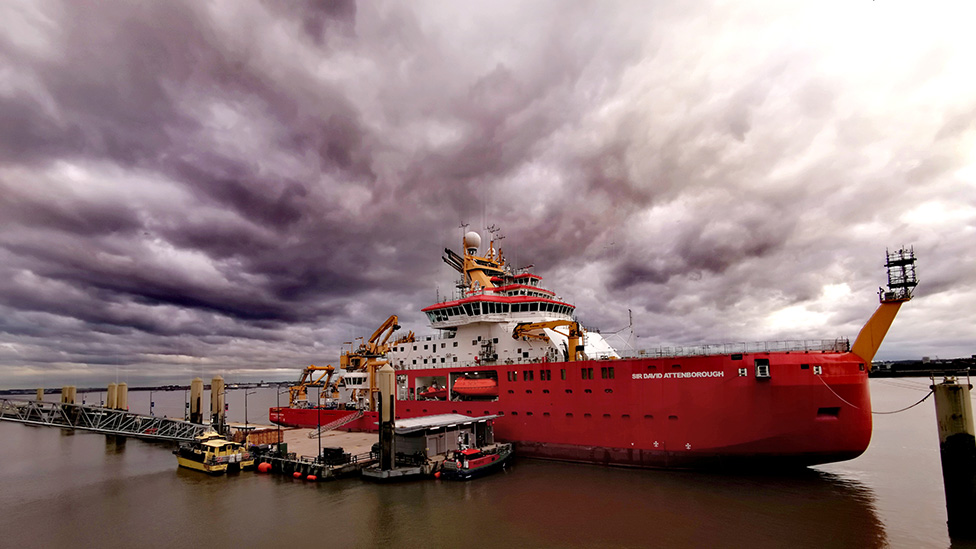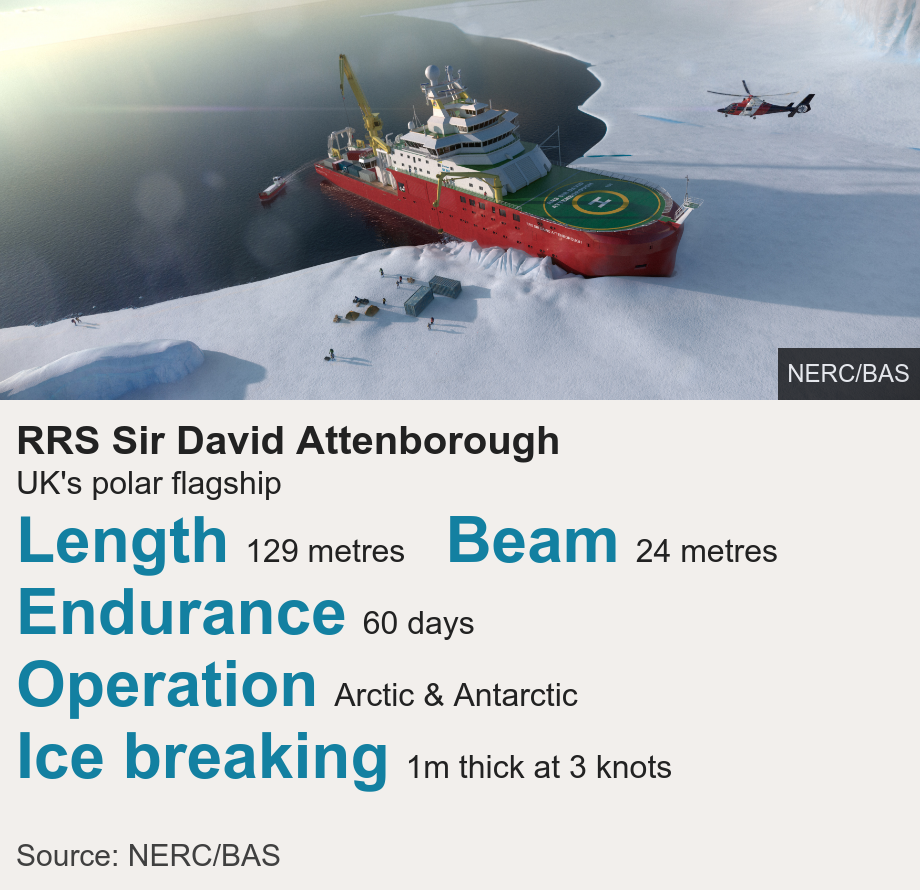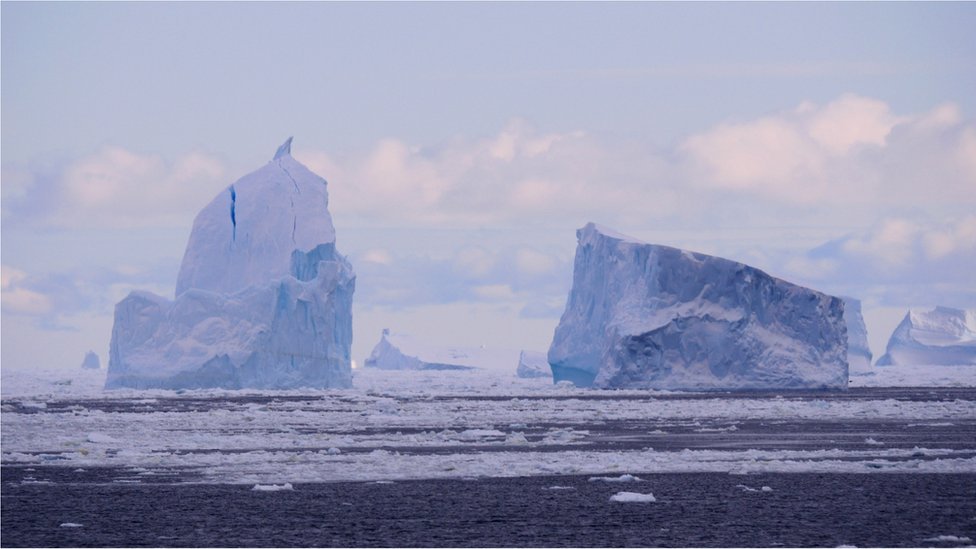
image copyrightRichard Turner/BAS
Britain’s new polar ship, the Sir David Attenborough, is all set to leave its Merseyside construction yard.
Four years in the making, the £200m vessel is about to venture out on a series of sea trials.
Sirens, tugboats and water cannon are expected to mark the Attenborough’s departure from builder Cammell Laird’s wet dock at Birkenhead.
Initially, the ship will only travel a few hundred metres down-river to Liverpool city’s cruise terminal.
But in the coming days she will sail across the north Wales coast to Holyhead, which will be her base for the next year.
Departure from Cammell Laird should occur at about 14:20 BST, shortly before the afternoon high tide.

image copyrightSPL
“This vessel is a true celebration of British expertise – from the team who built it right through to the scientific community that will call this ship home,” the company’s David McGinley said. “The RRS Sir David Attenborough is the single biggest and most ambitious build in the history of Cammell Laird and it’s an incredibly proud moment to see her embark on sea trials.”
Engineers need to run the rule over all the vessel’s systems and equipment before it can be released to support UK scientists in the Arctic and the Antarctic.
These trials will include an assessment of the Attenborough’s ice-breaking capabilities.
The design specifications called for a ship that could crunch through frozen floes with a thickness of up to 1m and at a speed of 3 knots (1.5m/s).
If all goes well with the tests, the Attenborough will make her first cruise to the Antarctic in November 2021.


Prof Jane Francis, the director of the British Antarctic Survey (BAS), said the new vessel represented a huge investment in the science of climate change.
“We’ve all heard about how the Arctic sea-ice is melting very fast, but the great ice sheets, such as Antarctica, are also melting in a warming world. The RRS Sir David Attenborough is going to allow us to get right up to the edge of the ice sheets, to deploy its new technologies, to really understand what’s going on,” she told BBC News.
BAS will operate the ship on behalf of its funding agency – the Natural Environment Research Council (Nerc).
The acquisition of the Attenborough completes Nerc’s fleet upgrade programme, which has already seen the introduction of two new “blue water” research vessels – RRS Discovery and RRS James Cook.

image copyrightRichard Turner/BAS
The 129m-long, 15,000-tonne Attenborough is the largest commercial ship built in Britain in three decades.
Her initial keel block was laid in October 2016, with the 10,000-tonne completed hull section entering the River Mersey in July 2018.
Since then, Cammell Laird has been installing all the fixtures and fittings, and undertaking a 60,000-litre paint job inside and out.
But while many of her systems can be, and have been, tested in wet dock, the ship’s readiness for service won’t be signed off until she’s been through deep-water trials.
“What we’ll be doing is going out on what are yard sea trials initially and that will involve the yard as the vessel owner effectively doing all their tests,” explained BAS ship captain Ralph Stevens.
“And then we’ll take the ship to Holyhead where we’ll take ownership of the vessel. And that’s when it really starts for us. We’ve got a year of trials ahead of us.”

image copyrightRob Larter/BAS
The Attenborough is a state-of-the-art polar research ship.
She has a helipad (helicopters are essential for exploration and safety), cranes and onboard labs, and she has an enhanced ability to deploy subs and other ocean-survey and sampling equipment.
One of her key features is an enclosed “moon pool”.
“This is basically a hole in the ship that goes all the way down to the surface of the ocean, through which you can deploy different instruments, whether that’s a biological net, or something to sample the ocean water,” BAS marine geophysicist Dr Kelly Hogan told BBC News.
Colleague Dr Rob Larter is excited by the sediment-coring capabilities offered by the Attenborough.
The muds around Antarctica retain a record of its past climate, and the new ship will be able to investigate this history over longer time periods and in more detail.
“The Attenborough will be equipped with a giant piston corer capable of collecting cores over 40m long,” Dr Larter said.
“This became an option because the size of the ship makes it possible to deploy and recover such a long core barrel length over the starboard side of the ship between the stern and the midships A-frame.”
The longest corer barrel length that can be deployed on BAS’s existing polar ship, the James Clark Ross, is just 16m.

image copyrightRob Larter/BAS
The Attenborough came to the public’s attention, of course, in an online initiative in which the public was asked to suggest a name.
“Boaty McBoatface” was the suggestion that garnered most support.
Ministers, however, rejected this as inappropriate, and ordered that one of the country’s most recognisable TV personalities, with a lifetime’s association with the natural world, be honoured instead.
With the Attenborough undergoing sea trials for a year, polar operations will continue to be supported for the time being by the James Clark Ross.
The JCR is currently at Harwich, waiting to depart for the British Rothera base on the Antarctic Peninsula. When the ship returns to the UK at the end of the southern polar summer season in 2021, it will be sold.
[email protected] and follow me on Twitter: @BBCAmos
Read MoreFeedzy


